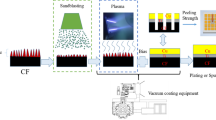Abstract
The adhesive properties in metal fiber laminates (FML) are essential regarding the bond strength of hybrid materials. The surface design of the metallic component has an important influence on the adhesive bonding. This work shows how the surface of electrolytically galvanized steel surfaces can be structured in a nanometer range by anodizing and how the adhesion properties in the FML can be significantly improved. To achieve this, homogeneous, reproducible nanoporous thin layers, in a range of 70 nm to 500 nm in thickness, were prepared in an anodization process of up to 10 min in a 0.2 M potassium hydroxide solution. In order to investigate the thin layer forming process as well as the wetting behavior, the current density was varied from 1 A/dm2 to 5 A/dm2 and the anodization time from 30 s to 600 s. For the wetting study, a drop shape analysis was carried out to provide information concerning the wetting behavior of the thin layers depending on the anodization parameters. Finally, shear tensile tests showed that the anodizing layer strengthens the interface in the FML, which results in an increased bond strength.

Graphical abstract









Similar content being viewed by others
References
Ostapiuk M, Surowska B, Bienias J (2014) Interface analysis of fiber metal laminates. Compos Interface 21(4):309–318. https://doi.org/10.1080/15685543.2014.854527
Reischer F, Pippel E, Woltersdorf J, Stöchel G, Marx G (2007) Carbon fibre-reinforced magnesium: improvement of bending strength by nanodesign of boron nitride interlayers. Material Chemistry and Physics 104(1):83–87. https://doi.org/10.1016/j.matchemphys.2007.02.086
Gan YX (2009) Effect of Interface structure on mechanical properties of advanced composite materials. Int J Mol Sci 10(12):5115–5134. https://doi.org/10.3390/ijms10125115
Ebbrecht C, Kudelka J (2011) Anodizing for bonding applications in aerospace: bridging the gap between the metallic and composite worlds (focus on anodizing). Products Finishing HighBeam Research. https://www.highbeam.com/doc/1G1-276137140.html
Samek L, Krizan D (2012) Steel – material of choice for automotive lightweight application. Metal 2012, Conference paper. https://www.researchgate.net/publication/259850559 Accessed 5 Jan 2012
Voon CH, Tukiman NT, Lim BY, Hashim U, Ten ST, Derman MN, Foo KL, Md Arshad MK (2014) Synthesis of zinc oxide thin film by anodizing. IEEE-ICSE2014 Proc. https://doi.org/10.1109/SMELEC.2014.6920887
Beedri N, Inamdar Y, Sayyed SA, Shaikh A, Jadkar S, Pathan H (2014) Growth of zinc oxide porous films via electrochemical anodization using glycerol based electrolyte. JCCT Ch&ChT 8(3):283–286 http://science2016.lp.edu.ua/jcct/growth-zinc-oxide-porous-films-electrochemical-anodization-using-glycerol-based-electrolyte
Dong J, Liu Z, Dong J, Ariyanti D, Niu Z, Huang S, Zhang W, Gao W (2016) Self-organized ZnO nanorods prepared by anodization of zinc in NaOH electrolyte. RSC Adcances 6(77):72968–72974. https://doi.org/10.1039/C6RA16995C
Wu X, Lu G, Li C, Shi G (2006) Room-temperature fabrication of highly oriented ZnO nanoneedle arrays by anodization of zinc foil. Nanotechnology 17(19):4936–4940. https://doi.org/10.1088/0957-4484/17/19/026
Kuan CY, Chou JM, Leu IC, Hon MH (2007) Formation and field emission property of single-crystalline Zn microtip arrays by anodization. Electrochem. Commun 9(8):2093–2097. https://doi.org/10.1016/j.elecom.2007.06.004
Kim SJ, Lee J, Choi J (2008) Understanding of anodization of zinc in an electrolyte containing fluoride ions. Electrochim Acta 53(27):7941–7945. https://doi.org/10.1016/j.electacta.2008.06.006
Park J, Kim K, Choi J (2013) Formation of ZnO nanowires during short durations of potentiostatic and galvanostatic anodization. Curr Appl Phys 13(7):1370–1375. https://doi.org/10.1016/j.cap.2013.04.015
Huang GS, Wu XL, Cheng YC, Shen YC, Huang AP, Chu PK (2007) Fabrication and characterization of anodic ZnO nanoparticles. Applied Physics A 86(4):463–467. https://doi.org/10.1007/s00339-006-3778-7
Shrestha NK, Lee K, Hahn R, Schmuki P (2013) Anodic growth of hierarchically structured nanotubular ZnO architectures on zinc surfaces using a sulfide based electrolyte. Electrochem Commun 34:9–13. https://doi.org/10.1016/j.elecom.2013.04.020
Sreekantan S, Gee LR, Lockman Z (2009) Room temperature anodic deposition and shape control of one-dimensional nanostructured zinc oxide. J Alloys Compd 476(1–2):513–518. https://doi.org/10.1016/j.jallcom.2008.09.044 Accessed 5 Jan 2012
He S, Zheng M, Yao L, Yuan X, Li M, Ma L, Shen W (2010) Preparation and properties of ZnO nanostructures by electrochemical anodization method. Appl Surf Sci 256(8):2557–2562. https://doi.org/10.1016/j.apsusc.2009.10.104
Kim YT, Park J, Kim S, Park DW, Choi J (2012) Fabrication of hierarchical ZnO nanostructures for dye-sensitized solar cells. Electrochim Acta 78:417–421. https://doi.org/10.1016/j.electacta.2012.06.022
Xu S, Wang ZL (2011) One-dimensional ZnO nanostructures: solution growth and functional properties. Nano Res 4(11):1013–1098. https://doi.org/10.1007/s12274-011-0160-7
Van der Leij M (1978) The possibility of black zinc oxide as spectrally selective coating for low temperature solar collectors. J Electrochem Soc 125(8):1361–1364. https://doi.org/10.1149/1.2131678
Mabon JC, Inal OT (1984) Optimization and evaluation of black zinc selective solar absorber surfaces. Thin Solid Films 115:51–73. https://doi.org/10.1149/1.1391564
Rocca E, Veys-Renaux D, Guessoum K (2015) Electrochemical behavior of zinc in KOH media at high voltage: micro-arc oxidation of zinc. 754:125–132. https://doi.org/10.1016/j.jelechem.2015.06.021
Acknowledgments
The authors would like to thank to the European Regional Development Fund and the State of North Rhine-Westphalia for funding the research project “LHybS” (www.tecup.de/lhybs/) and the lead partner Jülich (PTJ). We would also like to thank all staff of the Department of Technical and Macromolecular Chemistry (Prof. Guido Grundmeier) for giving us access to their Raman spectroscope for relevant measurements. We would also like to thank all staff of the Department of Coatings, Materials and Polymers especially Nadine Buitkamp (Prof. Wolfgang Bremser,) for the execution of FIB cuts and giving us the access to their contact angle device.
Author information
Authors and Affiliations
Corresponding author
Ethics declarations
Conflict of interest
The authors declare that they have no conflict of interest.
Additional information
Highlights
• The anodization process is suitable for structuring electrolytically galvanized steel surfaces
• Production of nanoporous layers with excellent wettability is feasible
• Anodizing layers with a thickness of up to 600 nm were observed (zinc layer remains intact)
• An increase in shear force of 58% is observed for anodized sheets joined to CFRP.
Rights and permissions
About this article
Cite this article
Engelkemeier, K., Mücke, C., Hoyer, K.P. et al. Anodizing of electrolytically galvanized steel surfaces for improved interface properties in fiber metal laminates. Adv Compos Hybrid Mater 2, 189–199 (2019). https://doi.org/10.1007/s42114-018-0071-0
Received:
Revised:
Accepted:
Published:
Issue Date:
DOI: https://doi.org/10.1007/s42114-018-0071-0




